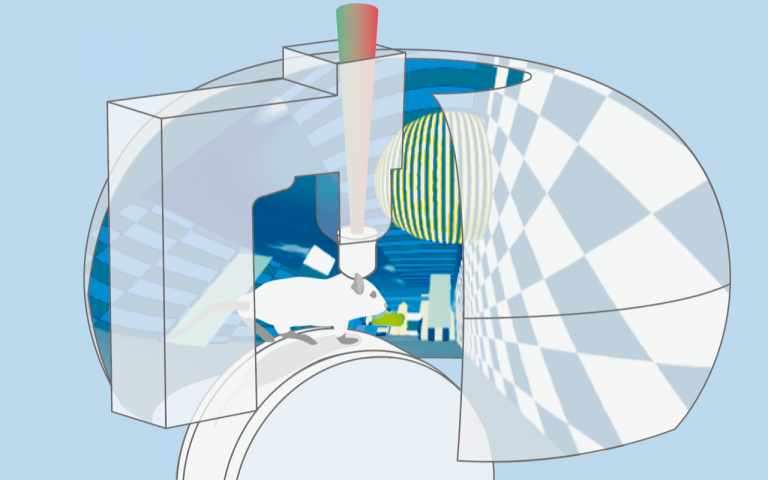Nov 9 2020
At University College London (UCL), neuroscientists have employed laser beams to “switch on” neurons in mice, offering new insights into the unknown workings of memory and demonstrating how memories support the brain’s inner GPS system.

Image Credit: Cell.
The research, described in the Cell journal, describes how scientists harnessed an “all-optical” method that involves using twin lasers to concurrently read and write the activity of “place cells” (a kind of neuron) in mice, as they steered through a virtual reality environment.
Incredibly, the researchers excited the place cells and could reactivate (or retrieve) the memory of a location where the mice acquired a reward, which in turn “mentally teleported” the mice, making them behave as if they were in the rewarded location.
This new study is based on the revolutionary work of Professor John O’Keefe (UCL Department of Cell and Developmental Biology), who was awarded the Nobel Prize in 2014 for the discovery of place cells. These cells are located in a region of the brain area known as the hippocampus. They turn active only when an animal moves to a particular location in the environment.
Place cells are believed to signify a cognitive map of the environment—similar to an inner GPS—and preserve location memory. The new UCL research is the first to pinpoint directly that place cell activity triggers the brain’s ability to steer.
The study findings offer a deeper insight into how memories are preserved, and the UCL researchers trust the findings could ultimately help to design new therapies for illnesses such as Alzheimer’s disease and dementia, which impact memory.
These results provide direct causal evidence that mice use the information represented by place cell activity to guide their behaviour. In other words, place cells really do tell the mouse where it is, and mice actually ‘listen’ to their place cells when they make decisions. This provides new insights about how memories are stored in the brain, as well as new tools for manipulating these memories to influence behaviour.
Dr Nick Robinson, Study First Author, Wolfson Institute for Biomedical Research, UCL
Dr Nick Robinson continued, “Disorders of memory—such as in dementia and Alzheimer’s—represent a huge cost to society. This work may eventually lead to a better understanding of these diseases, as well as new targets for therapeutic intervention.”
This study is a game-changer as it shows that we can use optical reading and writing of activity in specific neurons to manipulate memories, allowing us to better understand—and potentially improve—how neural circuit activity helps us to make decisions.
Michael Hausser, Study Senior Author and Professor, Wolfson Institute for Biomedical Research, UCL
The Experimental Study Explained
Scientists at UCL Wolfson Institute for Biomedical Research utilized a robust method, which involves combining two innovative technologies for employing light to read and write electrical activity in the brain.
Firstly, they designed neurons to express genetically encoded calcium sensors, which enable cells to light up when they are active. Next, light-sensitive “optogenetic” proteins were expressed in the same neurons, enabling them to trigger specific cells with beams of laser light, targeted using digital holography (the technology is the same as the one used in a laser light show).
By integrating these two methods, the researchers could both store and control activity in the same neurons in the brain of a mouse steering through virtual reality.
The UCL team used this method to carry out targeted activation of place cells in the hippocampus in mice steering to a particular location within the virtual world to gather a sugar-water reward.
First, they optically logged the activity of huge numbers of hippocampal place cells, detecting those which were active particularly at the rewarded location and which could thus form the foundation of the memory for that location. Then, they employed holographically targeted laser beams to trigger these particular place cells in another location in the virtual realm.
Notably, stimulation of place cells was adequate to recover the memory of the rewarded location, causing the mouse to look for the reward at the new location. Simply put, triggering the neurons with light “mentally teleports” the animal, making them behave as if they were in the rewarded location. This is the first proof of how the stimulation of place cells allows retrieval of the memory of one’s environment and helps them to steer.
This study received funding from Wellcome, the Gatsby Charitable Foundation, the European Molecular Biology Organization, the European Commission, the European Research Council, and the Medical Research Council.
Journal Reference:
Robinson, N. T. M., et al. (2020) Targeted Activation of Hippocampal Place Cells Drives Memory-Guided Spatial Behavior. Cell. doi.org/10.1016/j.cell.2020.09.061.